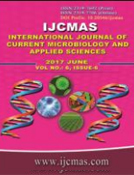


 National Academy of Agricultural Sciences (NAAS)
National Academy of Agricultural Sciences (NAAS)

|
PRINT ISSN : 2319-7692
Online ISSN : 2319-7706 Issues : 12 per year Publisher : Excellent Publishers Email : editorijcmas@gmail.com / submit@ijcmas.com Editor-in-chief: Dr.M.Prakash Index Copernicus ICV 2018: 95.39 NAAS RATING 2020: 5.38 |
An experiment was conducted during kharif (rainy season) with two maize (Zea mays L.) genotypes viz., CML-204 (waterlogging resistant) and HUZM-185 (waterlogging susceptible). Seeds were sown in plastic pots (size 15×15×15cm) having 5 kg pulverized soil. Waterlogging stress was imposed at 20 days after sowing by placing plastic pots into cemented container in such a way that the pots were fully submerged. Root samples were collected at intervals of 0, 1, 2, 3, 4, 5 and 6 days of waterlogging stress, afterward biochemical and antioxidant enzyme activities were analyzed. Waterlogging stress caused reduction in soluble sugar and starch contents in both genotypes. Genotype CML-204 had higher soluble sugar content (24.61 mg g1 FW) than HUZM-185 (20.47 mg g1 FW), however, starch content was higher in HUZM-185 (29.37 mg g1 FW) than in CML-204 (22.73 mg g1 FW) at 6 days of waterlogging stress. Hydrogen peroxide content increased in both genotypes and the magnitude was quite higher in HUZM-185 (1591.67 µM g-1 FW) than the CML-204 (1510 µM g-1 FW) at end of the stress. Peroxidase (POX) and superoxide dismutase (SOD) activities were significantly higher in CML-204 than HUZM-185; however, polyphenol oxidase (PPO) activity was higher in HUZM-185 in waterlogged plants. As compared to normal plants, waterlogging stress increased proline content in both genotypes. Present investigation revealed that resistant genotype (CML-204) has greater potential to minimize the waterlogging stress damage by efficiently scavenging H2O2 via intensifying antioxidant enzyme activities (POX, PPO and SOD) as compared to susceptible genotype (HUZM-185).
 |
 |
 |
 |
 |